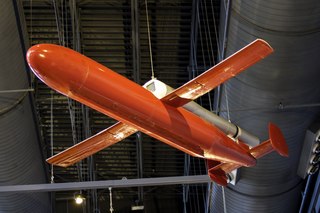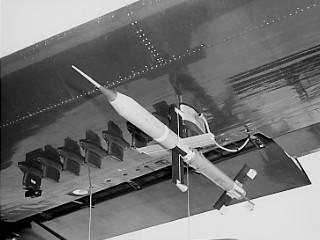
The AUM-N-2 Petrel, also known as Kingfisher C and AUM-2, was an air-to-surface missile produced as part of Project Kingfisher for the United States Navy. Intended for use against enemy surface ships and surfaced submarines, giving aircraft the ability to deliver aerial torpedoes from outside the range of defensive armament, it saw brief operational service in the late 1950s. The project was never considered a high priority by the Navy however, as it was useless against submerged submarines, which were considered the greatest potential threat.

Operation Bumblebee was a US Navy effort to develop surface-to-air missiles (SAMs) to provide a mid-range layer of anti-aircraft defense between anti-aircraft guns in the short range and fighter aircraft operating at long range. A major reason for the Bumblebee efforts was the need to engage bombers before they could launch standoff anti-shipping weapons, as these aircraft might never enter the range of the shipboard guns.

The Gorgon missile family was a series of experimental air-to-air, air-to-surface, and surface-to-surface missiles developed by the United States Navy's Naval Aircraft Modification Unit between 1943 and 1953. The immaturity of the technology involved meant that none of the Gorgon missiles achieved operational service, however they were extensively used in the development of guided missile controls and guidance technologies.

Project Kingfisher was a weapons-development program initiated by the United States Navy during the latter part of World War II. Intended to provide aircraft and surface ships with the ability to deliver torpedoes to targets from outside the range of defensive armament, six different missile concepts were developed; four were selected for full development programs, but only one reached operational service.

The VB-6 Felix was a precision-guided munition developed by the United States during World War II. It used an infrared seeker to attack targets like blast furnaces or the metal roofs of large factories. The war ended before it could be used operationally.

The LBD-1 Gargoyle was an American air-to-surface missile developed during World War II by McDonnell Aircraft for the United States Navy. One of the precursors of modern anti-ship missiles, it was extensively used as a test vehicle during the late 1940s.

The McDonnell TD2D Katydid was a pulsejet-powered American target drone produced by McDonnell Aircraft that entered service with the United States Navy in 1942, and continued in use until the late 1940s.

The Globe KD5G is a pulsejet-powered American target drone produced by Globe Aircraft Corporation that began development in 1949. Due to changing requirements for drone performance, it was only operated by the United States Navy for a short period.

The AQM-127 Supersonic Low-Altitude Target (SLAT) was a target drone developed during the 1980s by Martin Marietta for use by the United States Navy. Derived from Martin Marietta's work on the cancelled ASALM missile, SLAT proved to have severe difficulties in flight testing, and the project was cancelled during 1991.

The Creative Research On Weapons or Crow program was an experimental missile project developed by the United States Navy's Naval Air Missile Test Center during the late 1950s. Intended to evaluate the solid-fueled integral rocket/ramjet (SFIRR) method of propulsion as well as solid-fueled ramjet engines, flight tests were conducted during the early 1960s with mixed success.
The ASM-N-5 Gorgon V was an unpowered air-to-surface missile, developed by the Glenn L. Martin Company during the early 1950s for use by the United States Navy as a chemical weapon delivery vehicle. Developed from the earlier PTV-N-2 Gorgon IV test vehicle, the program was cancelled without any Gorgon Vs seeing service.

The AAM-N-4 Oriole was an early American air-to-air missile, developed by the Glenn L. Martin Company for the United States Navy. Designed for launch from carrier-based aircraft, the missile programme was cancelled before flight testing began, and the missiles produced were utilized as test vehicles.

The AAM-N-5 Meteor was an early American air-to-air missile, developed by the Massachusetts Institute of Technology and Bell Aircraft for the United States Navy. Initially, both air-launched and ship-launched versions were considered. Versions designed for launch from carrier-based aircraft proceeded to the flight testing stage before the project was cancelled.

The Naval Aircraft Modification Unit KDN Gorgon, originally designated TD2N, was an early jet-powered target drone developed by the Bureau of Aeronautics and constructed by the Naval Aircraft Modification Unit for use by the United States Navy. First flown near the end of World War II, it was cancelled due to problems with its engine in 1946.

The CTV-N-2 Gorgon IIC – also designated KGN, KUN, and CTV-2 – was an experimental drone, originally intended as a surface-to-surface missile, developed by the United States Navy near the end of World War II. It was used to test control and homing systems for guided missiles, and was also produced in small numbers as a target drone under the designations TD3N and KD2N.

The KA2N Gorgon IIA – also designated KU2N, CTV-4, and CTV-N-4 – was an air-to-air missile developed by the United States Navy near the end of World War II. Proving a failure in its designed role, it was repurposed as an experimental testbed for missile technology.

The Gorgon III – given the military designations KA3N, KU3N, CTV-N-6 and RTV-N-4 – was a rocket-powered air-to-air missile developed by the United States Navy near the end of World War II. With the end of the war, the program was changed to that of a research vehicle for missile control systems; both single and twin-rocket-powered versions were built and tested.

The ASM-N-6 Omar was a short-range air-to-surface missile developed for and evaluated by the United States Navy in the early 1950s. Intended to use existing unguided rockets as a basis and using a novel guidance system involving optical beam-riding, the program was unable to resolve difficulties with the guidance system and was cancelled without entering service.

The AUM-N-6 Puffin, also known as Kingfisher F and AUM-6, was an anti-ship and anti-submarine missile developed for use by the United States Navy in the late 1940s. Pulsejet-powered and intended to allow an aircraft to launch a torpedo or bomb from stand-off range, it was flight-tested but failed to enter operational service.

The SUM-N-2 Grebe, also known as Kingfisher E and SUM-2, was a rocket- and pulsejet-powered anti-ship and anti-submarine missile developed by the United States Navy in the late 1940s. Intended to allow a ship to deliver a torpedo at a significant distance from the launch location, it proved impractical in trials, and did not enter operational service.




















